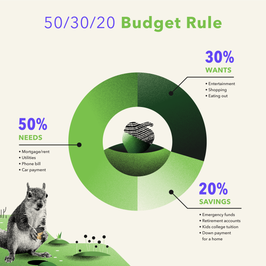Budgeting 101: Create a Budget in 7 Steps

Whether higher prices are making it harder to make ends meet or you simply want to improve your finances, creating a budget is key. And while budgeting can seem overwhelming, it's surprisingly easy to do.
There are many different ways to budget, so continue reading to learn about the top budgeting strategies that will help you get started.
What is a budget?
Budgeting often gets a bad rap because it's viewed as tedious or restrictive. But budgeting is simply creating and following a plan for spending your money. Creating a budget allows you to see how much you're spending on bills, groceries, entertainment, and other expenses, so you can make adjustments as needed.
A budget eliminates the guesswork of figuring out how much money comes in and goes out every month, and you can even use your budget to plan for future goals or adventures, such as a dream vacation.
4 budget plan options
Budgets aren't just for financial advisors and business executives; they have a place in your household too.
50/30/20 rule
For those that are intimidated by strict budgets and spending trackers, the 50/30/20 rule can be appealing. With the 50/30/20 approach to budgeting, your after-tax money is split into three buckets:
-
50% goes toward necessities: The largest of the three categories, your necessities include your rent or mortgage, utilities, groceries, insurance, student loan payments, and transportation. These are the essential expenses that you need to pay every month.
-
30% goes toward things you want: Next, think about the things you want that aren’t essential expenses. Vacations, electronics, entertainment, and dinners out with friends all fall under this category.
-
20% goes toward savings and retirement: Finally, 20% of your income goes toward your future goals, including your emergency fund and retirement accounts.
Money Fit, a non-profit organization, has a 50/30/20 calculator you can use to see how much you should put toward each category based on your income.
Zero-based budgeting
Zero-based budgeting is a more intensive form of budgeting than the 50/30/20 method. With this strategy, you total your income for the month and assign every single dollar a job, from recurring bills to savings for future goals. At the end of the budgeting period, the total should be zero — all income has been budgeted and assigned a job.
This budgeting strategy requires more time and effort upfront, but it also gives you greater control over where your money goes each month, and ensures you maximize every dollar.
Pay yourself first
With the “pay yourself first” method, budgeting begins by setting aside a portion of your paycheck for yourself before budgeting for any other expense or goal. Typically, this method recommends setting aside at least 10% for your short- or long-term goals, such as buying a home or retirement.
Once you’ve moved that money into savings or your investment account, you use the remainder to budget for your essential expenses and wants.
The idea behind the pay yourself first plan is that saving for the future is just as important — if not more so — than budgeting for other expenses. And when saving becomes a habit, you’ll be better able to meet your financial goals and make smarter money decisions in the future.
Cash envelope
If you struggle with impulsive shopping or credit card debt, the cash envelope budgeting system may be for you. With this strategy, you withdraw your paycheck amount — minus a cushion to prevent overdrafts — in cash.
You label actual, physical envelopes with the different spending categories, such as "rent," "food," and "entertainment." You budget how much to spend in each category, and place that amount of cash in the respective envelope.
When you make purchases or pay for services, you take money out of the designated envelope and use cash as the payment method. Once an envelope is out of money, you can't spend any more in that category.
Some people find it more effective than budgeting with a debit or credit card. Using the cash envelope system gives you a visual representation of your budget, and paying with real, tangible cash can help curb overspending.
How to budget in 7 steps
Now that you know about some of the most popular budgeting methods, you can test them out and decide which approach is best for you. When you're ready to get started, you can create a budget by following these seven steps:
Step 1: Understand your financial goals
Your budget isn't just about the money you have in your account and your expenses right now; it's also about your priorities and what you want to achieve in the future. A budget is an invaluable tool to achieve your goals.
For the first step, spend some time thinking about your short- and long-term financial goals. Some common examples include:
-
Building a six-month emergency fund
-
Buying a new car
-
Becoming a homeowner
-
Traveling to Europe
-
Having children
Figuring out your goals will help you prioritize where your money goes as you build a working budget.
Step 2: Total your take-home pay
Next, calculate how much money you have coming in every month. Take into consideration all sources of income, including your wages, tips, side hustles, child support, alimony, or other influxes of cash. If you work for a company and receive regular paychecks, this step is easy; you can just look at your most recent pay stub.
If you have irregular hours, are self-employed or freelance on the side, your income may fluctuate from month to month. In that case, look at your bank statements from the past three months. Add up all of the deposits for that time, and divide the total by three — that will give you an average monthly income to work with for budgeting purposes.
Step 3: List your essential expenses
List all of your essential living expenses, such as rent, electric bill, gas for your car and groceries. These are the non-negotiable expenses you have to pay every month.
Some of them, such as your rent or loan payments, will be fixed, meaning they’re the same amount every month. Others, such as your grocery bill, may change week to week and month to month. To account for those fluctuating expenses, look at your credit card and bank statements from the past three months. Add up what you spent in each category, then divide the total by three to get an average amount.
For example, let’s say you spent $200 on groceries in August, $350 in September and $275 in October. Altogether, you spent $825 on groceries over three months. Divide the $825 total by three, and you spent an average of $275 per month on groceries, a number you can use when setting a budget.
The Consumer Financial Protection Bureau (CFPB) has a helpful printable worksheet you can use when calculating your expenses.
Paying yourself by saving for emergencies or your retirement counts as an essential expense. Investing in your financial security and your future security should be a non-negotiable line item.
Step 4: Calculate your spending on non-essentials
It’s very easy to lose track of how much money you spend. With online shopping and contactless payments, we can buy things without even thinking about it. And over time, even small purchases -- a lipstick at the drugstore, app subscriptions, or beer and wings with friends -- can add up.
For this budgeting step, you’ll need to look at your bank and credit card statements from the past three months. Look at how much you spent on non-essential expenses, such as takeout meals, drinks with friends, movie tickets, clothes, video games or travel. Calculate how much money you spent in each category, then divide the total by three to get an average amount.
You may be surprised at just how much you spend in a given month on non-essentials.
You can review and track your spending with a pen and paper, your smartphone, or with apps like Mint or You Need a Budget.
Step 5: Compare your expenses to your income
Now that you know how much you typically spend every month, deduct the total amount from your monthly take-home pay.
Hopefully, you have a surplus, meaning you earn more money than you typically spend. If that’s the case, the remainder gives you an idea of what money you have to pursue your other financial goals. For example, the leftover money can help you pay off credit card debt faster, go toward a down payment on a new house, or cover travel expenses.
However, you may find that your expenses exceed your take-home pay. In that situation, you may have to make some difficult choices to cut your expenses or boost your income.
Step 6: Cut down (or increase!) where you need to
If your expenses outpace your income, you need to cut some corners and find some ways to increase your earnings.
To reduce your expenses, consider these tips:
Use apps to cancel subscriptions
It’s easy to subscribe for services and apps without realizing what you’re committing to, and all those small subscriptions can eat up a large part of your budget. You can use apps like Trim, Rocket Money and PocketGuard to identify recurring subscriptions and service fees and cancel them. These services usually take a percentage of your total savings rather than an upfront fee.
Reduce your housing expenses
Your rent or mortgage payment is likely your biggest expense. You can slash your housing cost by getting a roommate through Roomies or by renting out extra space on AirBnB or Neighbor.com.
Shop around
If you have recurring expenses like car insurance, cell phone service or internet, it pays to shop around and get quotes from leading competitors. In some cases, you may be able to get a cheaper rate for the same service and save money. Useful tools to help you comparisons hop include The Zebra, Policy Genius and CableTV.com.
Although reducing your expenses can be helpful, there are only so many areas you can trim. If you’ve slashed your expenses as much as you can, focus on increasing your income.
Ask for a raise
Your salary likely hasn’t kept pace with inflation. If you haven’t gotten a raise in a while, talk to your manager to see if it’s possible. When you make your request, come prepared with solid examples of how you’ve gone and above and beyond with your work. However, if your company is in financial trouble or your industry rife with layoffs, it may not be a good time to ask for a raise. Use your discretion!
Look for another job
Many people find that the only way to get a significant pay increase is to switch to a new job with another company. If your wages have stagnated, it may be a good idea to polish your resume and start networking for a new role.
Work nights or weekends
If you can, working part-time in the evening or on weekends can help you earn more money to pay down debt and boost your savings. While working two jobs isn’t sustainable for the long-term, it can help you get through tough periods and build a more stable future.
Consider a side gig
Side gigs allow you to earn extra money in your spare time, without having to commit to a particular schedule. You can work hourly or on-demand gigs with services like GigSmart, Instawork or TaskRabbit. Common jobs include food service, walking dogs, delivering groceries, assembling furniture and even gift wrapping.
Step 7: Stick to it - the hardest part!
Now that you've created a budget, trimmed your expenses and increased your income, it's time for the hard part: sticking to it! A budget isn't a set-and-forget tool. Even the most carefully-crafted budget is only effective if you actually follow it.
To make it easier to follow your budget, consider using a spreadsheet on your phone or budgeting apps to record your spending and track how much you spend in categories. You can also use your bank's autopay and bill pay services to set up automatic payments for monthly expenses and transfer money to your savings or investment accounts.
Remember, a budget is a living document, meaning it should be adjusted over time to reflect changes in your life. Whether you decide to move to another state, have a child or simply have a change in priorities, it's a good idea to revisit your budget quarterly to make sure your budget still works for you.
Budget example
The below example is a basic budget for someone that has $4,300 in take home pay. After deducting their savings amount and total expenses, they have $620 left over to put toward their other goals or extra spending.
|
Monthly Take-Home Income |
|
|
W-2 Job |
$4,000 |
|
Grocery Delivery Side Hustle |
$300 |
|
Total |
$4,300 |
|
Savings |
|
|
Retirement |
$350 |
|
Emergency Fund |
$150 |
|
Total |
$500 |
|
Expenses |
|
|
Rent |
$1,200 |
|
Utilities (Water, Electric) |
$150 |
|
Cable/Internet/Cell Phone |
$150 |
|
Student Loan |
$250 |
|
Car Insurance |
$130 |
|
Gas |
$100 |
|
Car Payment |
$250 |
|
Groceries |
$450 |
|
Healthcare (Insurance, copays) |
$200 |
|
Personal Items (Shampoo, household goods) |
$100 |
|
Gym Membership |
$50 |
|
Entertainment (Dining Out, Movies) |
$150 |
|
Total |
$3,180 |
|
Remaining Money After Expenses and Savings: |
$620 |
Top budgeting tips
No matter which budgeting method you choose to use, budgeting can help you meet your financial goals and improve your finances. To help you budget as effectively as possible, use these tips:
See what works for you
There is no one budgeting method that works for everyone. For example, some people find that they do best when they track every single expense as they make them or by using cash. Other people may find those ideas restrictive and frustrating. If that's the case, a less detailed budget like the 50/30/20 budgeting method may be a better fit. Try different budgeting strategies to see which method is the right fit for your needs.
Check in on a regular schedule
Your budget only works if you spend within the allotments for each category. To stay on track, you need to review your budget and your spending on a regular basis. Some people find that reviewing their bank and credit card accounts weekly is adequate, while others will need to check daily to keep their spending in check.
Your overall budget also needs to change along with you. As your lifestyle, goals and budgeting needs change, you need to update your budget accordingly. That's why it's important to check in on a regular schedule, such as quarterly or every six months.
Involve other people in your household
If your financial situation is impacted — or has an impact on — anyone else, make sure they’re involved with the budgeting and tracking processes. Whether you have a partner, roommate, or kids, budgeting is a team effort and everyone should have an understanding of budget categories, goals, and spending limits. Setting routine budget check-in dates for the whole household can help everyone stay focused on the goals.
Break occasional expenses into monthly payments
There are some expenses that you know are coming up, but that don’t happen monthly. For example, you may pay your car insurance twice per year, or you may spend money every year on gifts. Rather than having those expenses wreck your budget, you can account for them by including them in your monthly expenses.
For example, let’s say you normally spend $500 every year on holiday decor and gifts. If you’re like many people, you might charge that amount on a credit card, and spend months making payments and paying interest until it’s paid off. A better approach would be to incorporate that amount into your monthly budget.
If you spend $500 per year, that’s about $42 per month. If you add a line item in your budget for that amount and transfer $42 per month over to your savings, you’ll have the money in cash when you need it during the holiday season — no credit card needed.
Create visuals
It can be helpful to set up visual reminders for yourself, such as hanging pictures of your dream car on your refrigerator or setting the perfect house as your phone’s background. Some people with outstanding debt find that creating a chart and coloring it in every time they make a payment can help them stay focused on their repayment.
Save for emergencies
It’s inevitable; emergencies pop up. Your cat needs to visit the vet, your refrigerator stops working or you have an unexpected medical bill. To make sure that budget-wrecking emergencies don’t derail your budget, set aside money in a dedicated emergency fund each month.
Ideally, your emergency fund should include enough money to cover three to six months of expenses. But if that’s not within reach, start with a smaller amount and build it up over time.
Give yourself some wiggle room
No matter how thorough you are, there are going to be some expenses that surprise you. To make sure that budget issues don’t arise, budget a bit more than necessary for each category and set aside the extra in a “miscellaneous” budget item. That way, when the unexpected happens, you have some breathing room in your budget to cover it without tapping into the money set aside for other purposes.
The views expressed are generalized and may not be appropriate for all investors. Investing involves risk, including the loss of principal. Carefully consider your financial situation, including investment objective, time horizon, risk tolerance, and fees prior to making any investment decisions.








